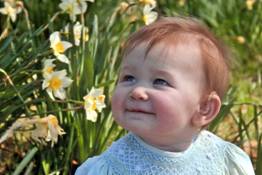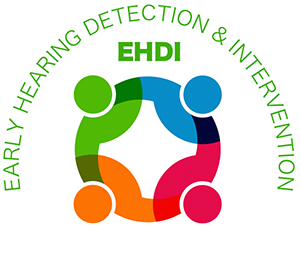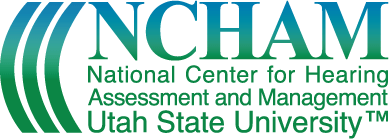Last Modified: 06/14/2023
Diagnostic Audiology

When infants with hearing loss receive timely and appropriate diagnostic and intervention services, they have positive speech, language and listening outcomes. Ideally, the newborn screening is completed before a baby is 1 month of age. If a baby does not pass the newborn screening, the next step is Diagnostic Audiology. The initial diagnostic tests must be completed as soon as possible so that any potential hearing loss can be diagnosed before 3 months of age. A baby identified with a hearing loss should be fit with hearing aids (if appropriate) and enrolled in an early intervention program well before 6 months of age.
The diagnostic evaluation is performed by a pediatric audiologist. A pediatric audiologist is a professional with a master's or doctoral degree in Audiology and the technical expertise and desire to work with infants and children. The audiologist performs a series of tests, described below, to determine if a hearing loss exists, and, if so, the type (part of the auditory system affected), degree (how much hearing loss exists) and configuration (frequencies or pitches that are affected) of the loss.
Key Components in a Diagnostic Audiological Evaluation of Infants and Children
Case History Documentation
The audiologist will collect information about family history of hearing loss, conditions that occurred during pregnancy including maternal illnesses, complications that occurred during labor or delivery, and time the infant spent in the neonatal intensive care unit (NICU). This information helps the audiologist determine if there are any pre, peri- or postnatal conditions that would indicate the infant is at increased risk for a progressive or late-onset hearing loss. See JCIH Risk indicators, appendix A.
Auditory Brainstem Response (ABR)
ABR testing is an electrophysiological measurement that allows the audiologist to obtain information about the condition of the inner ear and/or auditory nerve. It is the most critical procedure in the initial test battery because it is an accurate and reliable predictor of hearing loss in infants who are too young to respond to behavioral testing. ABR should include Clicks, Tone bursts, and Bone Conduction testing. The ABR measurement provides information on the degree, type, and configuration of a hearing loss and allows the audiologist to fit an infant with a hearing aid when needed.
Generally, infants less than 6 months of age do not need sedation for this test. When sedation is needed, the ABR is conducted in a special clinic room or hospital operating room. In either case, a physician must be on site and a medical professional must monitor the infant’s vital signs while the audiologist is performing the ABR. There are helpful techniques for preparing an infant for an ABR (with and without sedation). Read more about ABR Techniques.
Auditory Steady State Responses (ASSR)
ASSR testing is another electrophysiologic measurement of a baby’s hearing. The benefit of the ASSR is that the results may provide more frequency-specific threshold information for infants who have severe to profound hearing losses. This enables the audiologist to have more precise data to proceed with hearing aid fittings or determining cochlear implant candidacy. At the present time, ASSR is not available in all audiological clinics. The Joint Committee on Infant Hearing (JCIH) 2007 Position Statement does not recommend this procedure as the sole measure of auditory status in newborn and infant populations. Like ABR assessment, infants over 6 months of age may need to be sedated for ASSR testing. See appendix B for sedation info.
Otoacoustic Emissions (OAE)
A cochlea that is functioning normally not only receives sound, it also produces low-intensity, measurable sounds called OAEs. OAEs are absent when an infant/child has a sensorineural hearing loss of 30dBHL or greater. It is important to note that middle ear fluid, or negative middle ear pressure associated with otitis media, can interfere with OAE measurement. The middle ear must be clear for OAE equipment to accurately assess cochlear functioning. The condition known as “auditory neuropathy/dys-synchrony” is diagnosed by comparing OAE results (typically normal) with ABR results (typically abnormal). Additional information regarding OAE screening.
Tympanometry
Tympanometry tests the condition of the middle ear, the mobility of the eardrum (tympanic membrane) and the conduction of the middle ear bones, by creating variations of air pressure in the ear canal. When tympanometry is used with very young infants their small, soft ear canals may affect the test and give inaccurate results. Therefore, specialized equipment generating a high frequency probe tone is routinely used to increase the reliability and accuracy of tympanometry for children 0-6 months of age. Additional information regarding tympanometry.
Behavioral Audiometry
As a child matures and is able to provide hearing results behaviorally, hearing information can be plotted with even greater specificity. During audiometric testing, the audiologist finds the lowest intensity level (threshold) at which a child can detect sound at different frequencies. From this information, a graphic representation of the hearing loss, called an audiogram, is created. The hearing loss will typically be classified as mild, moderate, moderately severe, severe, or profound.
For infants 6 – 36 months of age, visual reinforcement audiometry (VRA) is recommended in addition to the tests described previously. In VRA assessment, the infant/child is seated on a caregiver’s lap in a soundproof booth. The child is trained to turn toward a toy (one that lights up and/or moves) when he/she hears a sound. Individual ear air conduction and bone conduction thresholds can be measured at all typical clinical frequencies (250, 500, 1000, 2000, 4000, 8000 hz) or at low, mid, and high frequencies. When this testing is used, a complete audiogram can be obtained.
After about 2 years of age, a toddler can be trained for conditioned play audiometry (CPA). In this assessment, the audiologist teaches the child to drop a ball in a bucket (or engage in some other enjoyable activity) when he/she hears a tone. CPA usually results in a complete individual ear audiogram by both air and bone conduction. Additional information regarding audiograms and bone conduction hearing.
Audiological Monitoring
Although universal newborn hearing screening is designed to identify infants who have congenital hearing loss, it is important to acknowledge that some infants may have mild losses that are not detected initially and become more severe over time (progressive loss). Other children experience a permanent hearing loss at some point after birth (late-onset or delayed-onset loss). If a child has unilateral, mild, or chronic conductive hearing loss or is “at risk” for progressive or delayed-onset hearing loss, audiologic monitoring is recommended. See JCIH Risk indicators, appendix A.


